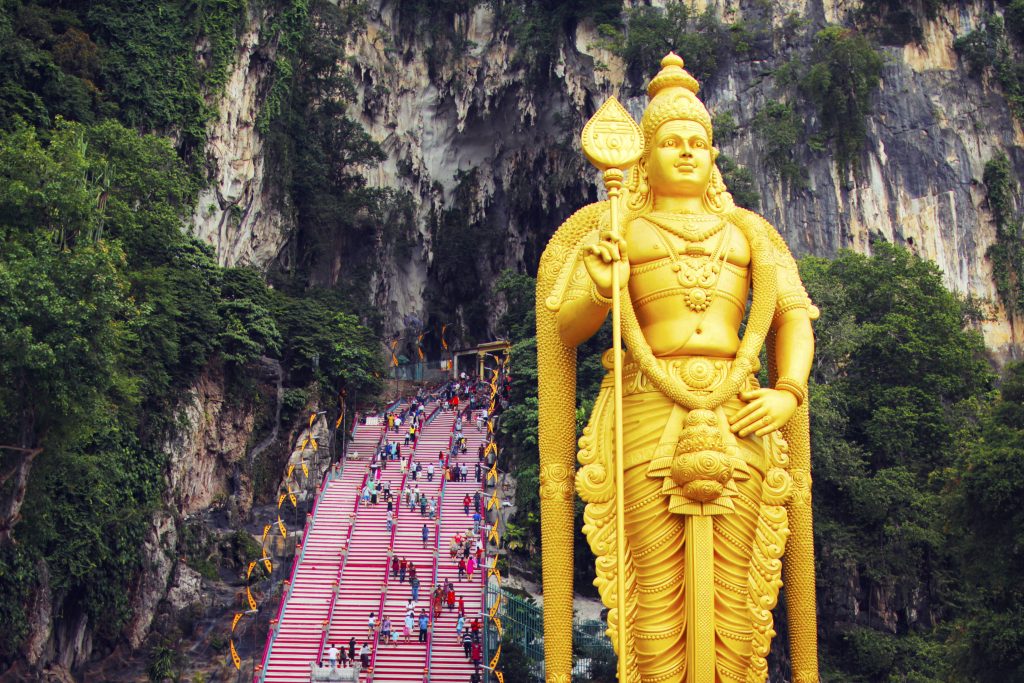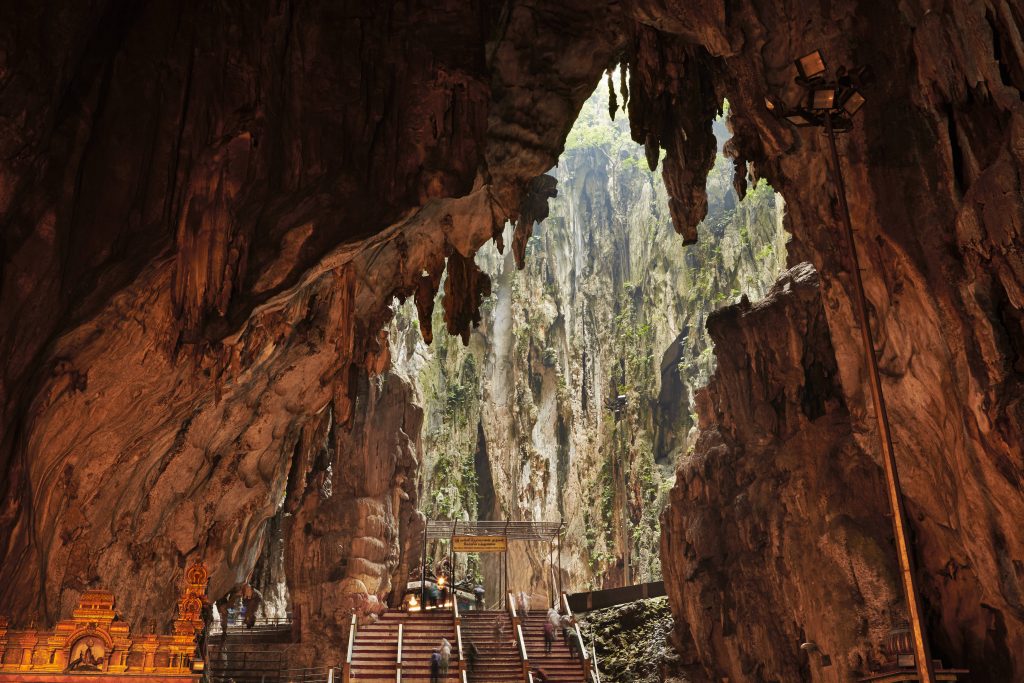Visiting Malaysia’s top tourist attraction: The Batu Caves
Batu Caves is a popular attraction in Malaysia. What are they and how can you get there? Click here to read everything you need to know.

Kuala Lumpur, Malaysia’s vibrant capital offers plentiful sightseeing opportunities, cultural experiences and nature oases. Whether you arrive into Kuala Lumpur by flight, or overland from Malaysia’s historic town of Penang, the first thing you will want to do is head out and explore its attractions. Aside from marveling at Malaysia’s twin towers, known as the Petronas Towers, Batu Caves is without a doubt the first attraction on every tourists’ list. The 272-step rainbow splashed stairway and the fascinating Hindu temple embedded in a cave is what makes this attraction unique and exciting. Read on to find out everything you need to know about a trip to Batu Caves.

A temple inside of a cave
Whilst Batu Caves is a popular attraction for tourists, it’s also a religious site for the Tamil Hindu community. In 1891, a leader of the Tamil Hindu community built a temple inside the caves. This temple is known today as the Temple Cave and is the most well-known cave. It’s the temple that most people initially think of when taking a trip to Batu Caves. After noting the fascinating shape of the entrance, the Indian leader decided to dedicate his shrine to Lord Murugan, the Hindu God of war. Hence the 42.7 meter (140 feet) high gold statue of Murugan standing at the foot of the leg-aching 272-step stairway.
The 5 Caves
What people don’t often realize is that there are actually more caves than just the main cave where the Cave Temple is located.
Ramayana Cave
This is the first cave you will see once you have exited the monorail. There is an entrance fee of 5 Ringgit ($1.19). Inside there are a few figures that portray the life story of Lord Rama, the 7th incarnation of God, Vishnu . The writings are in the ancient Indian language, Sanskrit, so it’s difficult for non-speakers to understand the full story.
Cave Villas
Is a set of two caves that are inhabited by animals such as birds, iguana and tons of fish in the pool. Here you can also see numerous statues of Hindu Gods, and learn about their history. The cost to enter is 15 Ringgits ($3.58).
Temple Cave
This is the main cave that hosts a shrine and a chamber. As of 1892, thousands of Hindu devotees visit this cave as part of the Thaipusam Festival that is held annually at the end of January. Whilst the festival is a religious celebration, members of the public are more than welcome to attend. The entrance to this cave is free.
Dark Cave
Unfortunately, as of 28th January 2019, the cave is no longer accessible to the public. Prior to the closure, tourists had the option to take a guided tour of the cave to search for the trapdoor spider (one of the rarest spiders in the world) snakes, bats and other critters that inhabit the cave.
Pro tip: The Batu Caves complex is open daily from 7 am until 9 pm.

Dress code
As the cave is considered a religious site, a modest dress code strictly applies. For women particularly, it is important to cover your shoulders and to cover your knees. If you happen to forget, there’s a stall at the foot of the stairway where you can rent a sarong. The cost of rental is 5 Ringgits and you will be refunded 2 Ringgits when you return it.
Climbing the stairs & photo opportunities
Initially, the climb up the stairs looks exhausting. But since the stairs were painted in all the colors of the rainbow; hues of red, orange, green, purple and more, in August 2018, the climb up is quite pleasant as there are ample photo opportunities along the way. However, be aware of the Macaque monkeys. They truly live up to their stereotype of being cheeky monkeys. They will have no qualms about snatching your food, or even your sunglasses from your face. A word of advice would be to avoid the monkeys, however as cute as they may look, as a trip to the hospital for a rabies jab might become a possibility. So, don’t feed or tease them.
Shopping & food around the caves
Aside from exploring the caves and making the rewarding climb up the 272 steps, there are plenty of places to indulge in a spot of shopping, treat yourself to a well-deserved drink, or even tuck into an appetizing curry. At the foot of the stairway, you will find shops selling little trinkets such as magnets and key-rings. Whilst opposite the car park, there are small Indian restaurants selling smoothies and every Indian food you can think of. Whilst the prices of meals are slightly higher than in central Kuala Lumpur, the prices are still reasonable for the portion sizes. For example, a dhosi with dips costs 7 Ringgit.
Getting to Batu Caves from Kuala Lumpur
Luckily for those that prefer to explore at their own pace, Batu Caves are just 13 km from central Kuala Lumpur and are conveniently located on the last stop of the blue line on the monorail. Once you arrive in Kuala Lumpur, you will realise that using the monorail couldn’t be more efficient. All you need to do is locate the one nearest to where you’re staying and purchase your token at the kiosk or self-serving machines. Be aware though, if you’re accommodation is not along the blue line, you will need to change stations.
Prices of the metro depend entirely on the length of the trip but either way, you won’t pay more than a few Ringgits per journey. For example, if you’re staying at the new and modern Dorms KL2, you can take the brown or orange line at Plaza Rakyat to Bandaraya for 1.20 Ringgits (29 Cents). You will then need to cross over the road to Bank Negara station, which is along the blue line that goes directly to Batu Caves. This ticket costs just 2.30 Ringgits (55 Cents) and the journey takes 20 minutes.
If you’ve not yet conquered the monorail system in Kuala Lumpur, then you also have the option to take a day trip with a tour company, who will pick you up from your hotel and drop you off. Prices for half-day trips range from $14 upwards.
To conclude, a visit to Kuala Lumpur wouldn’t be complete without taking a visit to Batu Caves. With the monorail providing an effortless way of reaching one of Malaysia’s top attractions for minimal costs, there’s no excuse not to visit. Once you arrive, you can admire the colorful stairway and visit the fascinating Cave Temple for FREE, before treating yourself to a spot of shopping and a delicious Indian lunch. Just remember to dress modestly for your trip and not to bring nuts or bananas for the cheeky inhabitants.






